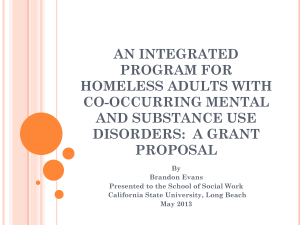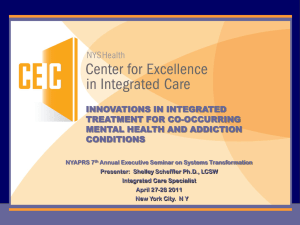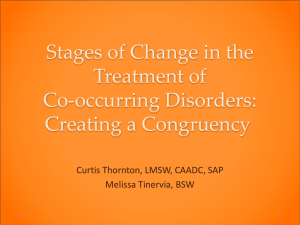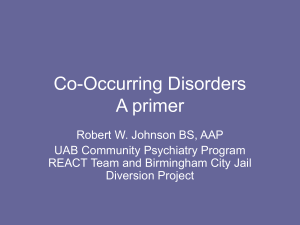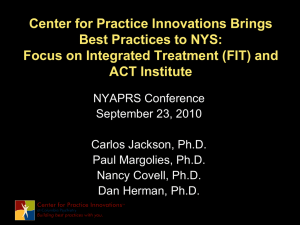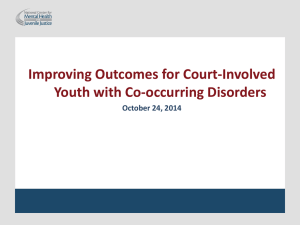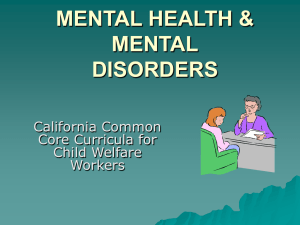Co-occurring: Integrated Model
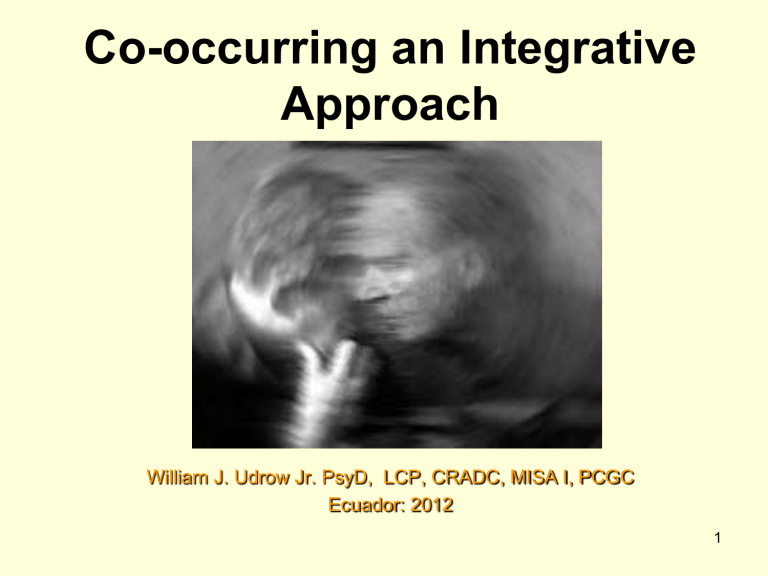
Co-occurring an Integrative
Approach
William J. Udrow Jr. PsyD, LCP, CRADC, MISA I, PCGC
Ecuador: 2012
1
Co-occurring
Mental and substance use conditions often cooccur. In other words, individuals with substance use conditions often have a mental health condition at the same time and visa versus.
Individuals who have at least one mental disorder as well as an alcohol or drug use disorder. While these disorders may interact differently in any one person (e.g., an episode of depression may trigger a relapse into alcohol abuse, or cocaine use may exacerbate schizophrenic symptoms), at least one disorder of each type can be diagnosed independently of the other.
( SAMSHA , 2012)
2
Co-occurring
• The term "co-occurring disorders" typically refers to an individual having co-existing mental health and substance use disorders. There are a number of other terms that have been used to describe people in this category as well, including:
• Dually diagnosed
• MICA (mentally ill chemical abusers)
• MISA (mentally ill substance abusers)
• CAMI (chemical abuse and mental illness)
• SAMI (substance abuse and mental illness)
3
Co-occurring
Some of the most common psychiatric disorders seen in patients with co-occurring addiction issues include.
• schizophrenia
• bipolar disorder
• borderline personality disorder
• major depression
• anxiety and mood disorders
• post traumatic stress disorder
• pathological gambling
• sexual and eating disorders
• conduct disorders
• attention deficit disorder
4
Co-occurring
Clients being treated for mental health disorders also often abuse the following types of substances.
• alcohol
• nicotine
• opiates
• sedatives
• stimulants
• marijuana
• hallucinogens
• prescription drugs
5
Co-occurring: U.S. Statistics
Serious mental illness (SMI) is strongly correlated with illicit drug use and cigarette use. Adults with serious mental illness were more than twice as likely as those without serious mental illness to use an illicit drug and to smoke cigarettes in the past year. Among persons with serious mental illness , 26.5 percent used an illicit drug in the past year, while among those without serious mental illness the rate was 10.5 percent.
Similarly, among adults with serious mental illness , the rate of cigarette use was 44.9 percent, while among adults without serious mental illness the rate was only 24.9 percent.
See Figure 8.3.
(SAMSHA, 2008),
6
Co-occurring: U.S. Statistics
7
Co-occurring: U.S. Statistics
Approximately 8.9 million adults have co-occurring disorders; that is they have both a mental and substance use disorder.
(Mental Health Advisory Team Six, 2009).
In 2002, more than half of adults with co-occurring serious mental illness serious mental illness and a substance use disorder (a total of 2 million adults) received neither specialty substance use treatment nor mental health treatment during the past year.
(NSDUH, 2004).
8
Co-occurring: U.S. Statistics
Among adults with co-occurring serious mental illness and a substance use disorder, women were more likely to receive mental health treatment in the past year than men
The rate of perceived unmet need for mental health treatment was higher than the rate of perceived unmet need for substance use treatment among adults with co-occurring serious mental illness and a substance use disorder.
(NSDUH, 2004).
9
Co-occurring: U.S. Statistics
Receipt of Mental
Health or
Substance Use
Treatment in the
Past Year among Adults
Aged 18 or
Older with Co-
Occurring serious mental illness and a
Substance Use
Disorder
10
Co-occurring: Integrated Model
• Integrated treatment works
• Integrated treatment or treatment that addresses mental and substance use conditions at the same time is associated with lower costs and better outcomes such as:
• Reduced substance use
• Improved psychiatric symptoms and functioning
• Decreased hospitalization
• Increased housing stability
• Fewer arrests
• Improved quality of life
11
Co-occurring: Integrated Model
• Integrated treatment
Integrated treatment produces better outcomes for individuals with co-occurring mental and substance use disorders. Without integrated treatment, one or both disorders may not be addressed properly. Mental health and substance abuse authorities across the country are taking steps to integrate systems and services, and promote integrated treatment.
12
Co-occurring: Integrated Model
• Systems Integrated treatment
Systems integration focuses on reorganizing the framework within which agencies and programs operate. It includes integrated system planning, implementation, and continuous quality improvement including developing mechanisms for addressing.
13
Co-occurring: Integrated Model
• Services integration:
Services Integration refers to the process of merging separate clinical services to meet the individual's substance abuse, mental health, and other needs.
• integrated screening for mental and substance use disorders
• integrated assessment
• integrated treatment planning
• integrated or coordinated treatment
• continuing care
14
Co-occurring: Integrated Model
In the State of Connecticut the Department of
Mental Health & Addiction Services applied the following 7 principles to their integrated treatment in 2010:
• Integrated: The same clinician (or team of clinicians) provides treatment for mental illnesses and substance use disorders at the same time.
• Comprehensiveness: When needed, access to residential services, case management, supported employment, family psychoeducation, social skills training, training in illness management, and pharmacological treatment is available.
15
Co-occurring: Integrated Model
• Assertiveness: Clinicians must make every effort possible to actively engage reluctant individuals in the process of treatment and recovery.
• Reduction of negative consequences: Reduce the negative consequences of substance use, while developing a good working alliance that can ultimately help develop the motivation to address their substance use and mental health challenges.
• Long-term perspective: Recognizing that each individual recovers at his or her own pace, given sufficient time and support.
• Motivation-based treatment: Interventions must be motivation-based – that is, adapted to clients’ motivation for change.
• Multiple psychotherapeutic modalities: Including individual, group, and family approaches has been found to be effective.
16
Co-occurring: Evidenced Based
Treatment
Evidence-based practices are at the core of stage-wise treatment:
From the earliest moments of the treatment process through sustained periods of remission, integrated treatment specialists use numerous evidence-based tools and practices that can help make treatment a success. Treatment includes:
• Integrated screening and assessment techniques
• Treatment planning strategies
• Motivational interviewing
• Cognitive behavioral therapy
• Peer support
17
Co-occurring: Evidenced Based
Treatment
• Stage-wise treatment helps people build meaningful lives
• Most people with co-occurring disorders want to recover and pursue meaningful goals. For many individuals, stage-wise treatment provides a path to recovery —a process that can drastically improve the quality of their lives.
18
Integrated
Treatment for Co-Occurring
Disorders
An Evidence-Based Practice
19
What Are Evidence-Based
Practices?
•Services that have consistently demonstrated their effectiveness in helping people with mental illnesses achieve their desired goals
•Effectiveness was established by different people who conducted rigorous studies and obtained similar outcomes
20
Examples of Evidence-Based
Practices
– Integrated Treatment for Co-Occurring
Disorders
– Supported Employment
– Assertive Community Treatment
– Family Psycho-education
– Illness Management and Recovery
21
Why Implement Evidence-Based
Practices?
•According to the President’s New Freedom
Commission on Mental Health:
State-of-the-art treatments, based on decades of research, are not being transferred from research to community settings
22
Why Implement Evidence-Based
Practices?
•According to the President’s New Freedom
Commission on Mental Health:
I f effective treatments were more efficiently delivered through our mental health services system . . . millions of Americans would be more successful in school, at work, and in their communities
—Michael Hogan, Chairman
23
What Is Integrated Treatment for
Co-Occurring Disorders?
•Integrated Treatment is a research-proven model of treatment for people with serious mental illnesses and co-occurring substance use disorders
•Consumers receive combined treatment for mental illnesses and substance use disorders from the same practitioner or treatment team.
They receive one consistent message about treatment and recovery
24
Practice Principles for Integrated
Treatment for Co-Occurring Disorders
Mental health and substance abuse treatment are integrated to meet the needs of people with co-occurring disorders
Co-occurring disorders are treated in a stagewise fashion with different services provided at different stages
Integrated treatment specialists are trained to treat both substance use and serious mental illnesses
Motivational interventions are used to treat consumers in all stages, but especially in the persuasion stage
25
Practice Principles for Integrated
Treatment for Co-Occurring
Disorders
Substance abuse counseling, using a cognitive-behavioral approach, is used to treat consumers in the active treatment and relapse prevention stages
Multiple formats for services are available, including individual, group, self-help, and family
Medication services are integrated and coordinated with psychosocial services
26
Treatment is Integrated
•Mental health and substance abuse treatment are evaluated and addressed
– Same team
– Same location
– Same time
•Treatment targets the individual needs of people with co-occurring disorders and is integrated on organizational and clinical levels
27
Treatment is in a Stage-Wise Fashion
• Precontemplation —
Engagement
•Assertive outreach, practical help (housing, entitlements, other), and an introduction to individual, family, group, and self-help treatment formats
Action — Active treatment
Counseling and treatment based on cognitive-behavioral techniques, skills training, and support from families and self-help groups
Maintenance — Relapse prevention continued counseling and treatment
• Contemplation and
Preparation — Persuasion
•Education, goal setting, and building awareness of problem through motivational counseling based on relapse prevention techniques, skill building, and ongoing support to promote recovery
28
Integrated Treatment Recovery
Model
Hope is critical
Services and treatment goals are consumerdriven
Unconditional respect and compassion for consumers is essential
Integrated treatment specialists are responsible for engaging consumers and supporting their recovery
29
Integrated Treatment Recovery
Model
•Focus on consumers’ goals and functioning, not on adhering to treatment
•Consumer choice, shared decision making, and consumer/family education are important
30
Integrated Treatment Recovery Model
•Integrated treatment is associated with the following positive outcomes:
– Reduced substance use
– Improvement in psychiatric symptoms and functioning;
– Decreased hospitalization
– Increased housing stability
– Fewer arrests and
– Improved quality of life
-(Drake et al.,2001)
31
Summary
•Integrated Treatment for Co-Occurring Disorders is effective in the recovery process for consumers with co-occurring disorders
•The goal of this evidence-based practice is to support consumers in their recovery process
•In Integrated Treatment programs, the same practitioners, working in one setting, provide mental health and substance abuse interventions in a coordinated fashion
•Consumers receive one consistent message about treatment and recovery
32
Integrative Approach: Therapy
A comprehensive integrative approach when providing therapy should including the following at a minimum:
• Pharmacotherapy Interventions
• Cognitive behavioral interventions
• Constant reassessing symptoms and behaviors related to both mental illness and substance using.
• Networking within the milieu (medical staff)
• Networking outside of the milieu (community resources/family involvements/12-step model
(MISA groups).
33
Integrative Approach: Therapy
• Pharmacotherapy Interventions
Psychiatric medications can be used to rebalance the neurochemistry of mental illness: psychopharmacology is the primary form of clinical treatment. Common medication therapy will include: antidepressants/mood stabilizers/antipsychotics and anti-anxiety medications.
(Inaba & Cohen, 2000).
Beware of addictive medication (some anti-anxiety and pain medications) and keep psychiatrist and other medical professions aware. Possible
“drug seeking behaviors).
34
Integrative Approach: Therapy
• Cognitive behavioral interventions
Research has generally confirmed that a combination of cognitive-behavior therapy and pharmacotherapy is somewhat better than either modality alone (especially for patients with severe or chronic depression) and that cognitive-behavior therapy is associated with a lower risk for relapse than is pharmacotherapy.
(Gloaguen,1998).
35
Integrative Approach: Therapy
• Constant reassessing symptoms and behaviors related to both mental illness and substance using.
Each session the therapist/clinician needs to assess symptoms related to both psychiatric and substance using behaviors: “how are the medications working? How are the voices?
Difficulty with sleep? Have you used any substance since our last session?” Once symptoms and behaviors are reported as stable therapy can be progress.
36
Integrative Approach: Therapy
• Networking within the milieu (medical staff).
Psychiatrist and nurses are trained to manage symptoms. Also the training of a psychiatrist usually involves a minimum of chemical dependence knowledge.
When a consumer presents with symptoms that may resemble a diagnostic disorder the consumer may be detoxing, experiencing PAWS and/or just drug seeking. Therefore, staffing with psychiatrist, nurses and other healthcare professional is demonstrating a integrative approach.
37
Integrative Approach: Therapy
• Networking outside of the milieu (community resources/family involvements/12-step model
(MISA groups).
Evidence based supportive employment can enhance an consumers self-esteem.
Family involvement in therapy with pschoeducation is valuable and evidenced based.
12-Step groups use cognitive behavior approaches to remaining substance free.
38
Reference
DMHAS Co-Occurring Enhanced Program Guidelines(2009). http://www.ct.gov/dmhas/lib/dmhas/cosig/CODenhancedguidelines.pdf
Gloaguen, V., Cottraux. J., Cucherate, M., & Blackburn, I. M. (1998). A meta-analysis of the effects of cognitive therapy in depressed patients. Journal of Affective Disorders, 49, 59-72.
Inaba, S. D. & Cohen, E. W. (2000). Uppers, Downers, All Arounders :
Physical and Mental Effects of Psychoactive Drugs. Oregon: CNS
Publications, Inc.
Mental Health Advisory Team Six. (2009). Operation Iraqi Freedom 07-09.
Washington,
DC: Office of the Surgeon, Multi-National Corps-Iraq & Office of the Surgeon
General, United States Army Medical Command.
National Survey on Drug Use and Health (NSDUH, 2004). Adults with Co-Occurring
Serious Mental Illness and a Substance Use Disorder.
SAMSHA, (2008), Chapter 8: Prevalence and Treatment of Mental Health Problems http://www.samhsa.gov/data/nhsda/2k1nhsda/vol1/Chapter8.htm
Substance Abuse and Mental Health Services Administration ( SAMHSA , 2012). About
Co-Occurring: http://www.samhsa.gov/co-occurring/
39
